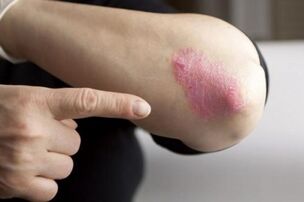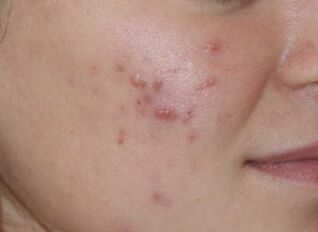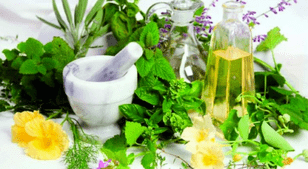In this article we look at the early stage of psoriasis, what is its cause and the mechanism of formation of the damaged areas. By following our recommendations, you can recognize the symptoms of psoriasis in the early stages and eliminate them.
Early signs of psoriasis
Patients may have different initial signs of psoriasis. This disease is characterized by an acute onset, a short-lived rash. The primary rash is also known as a duty rash or protective rash.
The first phase lasts a few weeks. The duration of this period of the disease depends on the general condition of the body and its protective capacity.
The rash consists of papules (pimples) that are small in size from pale pink to red, that are towering on the skin. They are dense to the touch.
After a while, you should see the silvery-white scales that are easy to remove. Skin inflammation, swelling, redness.
Specialists define 3 characteristics of psoriasis to distinguish it from other diseases:
| Features | Features |
| Stearin stain. | This is a scaly, plaque accompanying the appearance of small scales. |
| Psoriasis film. | The last layer that can be removed from the skin after the scaly layer. This layer is similar to plastic wrap. |
| Blood fog or Auspitz. | The appearance of blood droplets violates the integrity of the psoriatic membrane. |
Rashes come of different shapes: dot shape, teardrop shape, coin shape, annular, diffuse.
In addition to a rash, patients are also concerned about peeling, redness, and itching of varying intensity.
Psoriasis of the elbow

Plaque psoriasis is characteristic of the elbow area. At first, single red papules appear. Then the skin starts to flake off and it's rough.
Psoriasis of the feet
First sign: a small rash, inflammation and swelling of the skin. Typical localization: knees and feet. Over time, the skin flakes off, and the disease begins to progress.
Psoriasis on the hands
The first papules are found on the extensor part of the joint (on the finger and the elbow area). Quite often, the rash occurs on the palms of the hands along with lesions in the feet. Psoriatic arthritis sometimes occurs. It affects joints in many different sizes. It is characterized by swelling, redness and deformation of the joint, a painful sensation that can be bothering.
Psoriasis on the nails
The appearance of a nail disease looks like a fungal infection. First, longitudinal grooves and concave points appear along the edge of the foundation. The process of moving closer to the base of the nail over time. Nails dull and thickened. As the disease progresses, nails may fall off.
Psoriasis on the head
Hives location: front, back of ears, and neck area. The papules are accompanied by scaly and itchy skin. Damaged spots are usually damp and cracked. The characteristic symptom is a "psoriasis crown". It occurs when the rash goes beyond the growth of the hair.
Psoriasis on the face
The disease rarely affects the front of the head. Areas of the rash: eyelids, nasal folds, around the eyes, in the eyebrows, on the cheeks in a fine mesh form.

Characteristics of early stage psoriasis in children
To determine if a child has psoriasis, the first thing to consider is the redness between the folds of the skin and the appearance of small bumps (papules) in areas that friction with clothing and irritation. application. Children become restless due to itching and burning.
Need to know! In newborn babies, if not properly examined, early psoriasis can be mistaken for allergies, genetics, rash, diaper dermatitis. A special feature of psoriasis is the presence of a clear contour.
It should be noted that congenital psoriasis in children is characterized by more obvious clinical manifestations from the moment of birth.
Children with weak immunity after a severe infection are at risk of psoriasis. Special attention should be paid to children whose parents have psoriasis.
Mechanism of the formation of the psoriatic plaque
Psoriasis nodules are areas where an inflammatory response and over-formation of keratinocytes (epithelial cells) occurs. In this case, an excessive number of capillaries is formed in the dermis. Infiltration (immersion) of damaged skin with lymphocytes and macrophages leads to thickening and thickening of the skin. As a result, light gray spots are formed that look like hard waxy.
Important! Usually, the cuticle is replaced every 30 days. With psoriasis, the duration of this process is significantly reduced. Cell division, maturation, and death in this disease occur in as little as 5 days. Due to the speed of the pathology, communication between cells is lost.
Cause of what happened
Experts identify some provocative factors:
- Genetic predisposition.It is thought that the human body has genetic breakdown, leading to hyperkeratosis.
- Disruption of the immune system,leads to increased production of lymphocytes (T cells) and inflammation. The autoimmune response is not ruled out - damage to one's own cells and tissues due to their perception is foreign.
- Endocrine pathology,metabolic disorder.
- Diseases of the nervous system.
- Psychology - emotional stress, excessive stress.This factor is a trigger for the development of the disease, and also contributes to the worsening of the disease. In a stressful situation, the body secretes hormones and a number of biochemical reactions lead to the appearance of a rash and scales.
- Drinking alcohol,drugs, smoking.
Need to know!Children whose parents have psoriasis are at higher risk.
Diagnosis
If you suspect you have psoriasis, see a dermatologist. As a rule, after an external examination and evaluation of the condition of the damaged skin areas, he will establish a diagnosis. In rare cases, when doubts arise and are difficult to diagnose, the doctor will prescribe additional methods of research. These include:
- Skin biopsy- procedure for sampling of damaged skin. Helps to identify changes at the cellular level.
- Blood test.Helps to identify the presence of inflammation and rule out other diseases.
- Joint x-ray.It is used exclusively for joint pain to rule out the development of psoriatic arthritis.
- Inoculation of bacteriafrom the oropharynx. It is prescribed to confirm the form of teardrop-shaped psoriasis and to rule out acute pharyngitis.
- Test for potassium hydroxide.Helps get rid of fungal infections.
Treatment of disease
Unfortunately, there is no way to cure today's illness. Therefore, the primary goal of therapy is to eliminate symptoms and stop recurrence with an increase in the time of remission (the period of time that weakens and disappears symptoms of the disease). Therefore, treatment should be comprehensive and long-term.
After diagnosing and determining the stage and severity of the disease, the dermatologist chooses the necessary treatments. Before starting treatment, adjustments to the patient's diet and lifestyle are made. All factors that can cause an exacerbation of the disease must necessarily be ruled out.
In the early stage, the doctor can prescribe:
| Drug group | Drug name | Expected effects and treatment features. |
| Keratolytics | Betamethasone. | Improves exfoliation. |
| Vitamins | Vitamin D3 or A. | derivativesImproves general condition of body and skin. |
| Non-hormonal topical preparations with an anti-inflammatory effect | Clemastine, Promethazine hydrochloride. | Inflammation, redness, swelling. |
| Lubricating ointment | Coal oil extraction | Improves healing. |
| Medicines containing solidol | Has a positive effect on the cure, except itching. | |
| Salicylic Acid Ointment | Salicylic Acid | Accelerates the healing process and promotes the desquamation process. |
In the early stages, do not use strong drugs. The drugs should be used on the skin, doctors indicated oral use in case of severe disease.
In addition to drug treatment, specialists also prescribe physiotherapy tips:
- UFO (ultraviolet radiation).
- Bath: paraffin, radon, sulphide.
- Family therapy.
Traditional treatments
At home, it is possible to use folk formulas for treatment. It should be done exclusively in conjunction with the primary treatment prescribed by a dermatologist and only after consulting a doctor.
There are many recipes aimed at improving the general condition of the body, as well as topical remedies to eliminate the outward manifestations of the disease. One wire, flaxseed oil, celandine, calendula ointment work well.

Consider the most popular formulas for alternative treatments:
Ointment for psoriasis
Element:
- St. John's wort - 20
- Celandine (grass with roots) - 20 g.
- Propolis - 20g.
- Calendula -10 years
- Vegetable oil - 10 g.
How to cook:Crush all plants until smooth. Then add vegetable oil and mix well. Store in a cool and dark place.
How to use:Lubricate diseased skin 2-3 times a day.
Result:Herbal ointment will help to get rid of inflammation.
Egg ointment
Element:
- Chicken eggs - 2 pcs.
- Sunflower oil - 1 tablespoon
- Acetic acid - 40 g.
How to cook:Beat eggs and butter. Then add acetic acid to the mass obtained and mix well.
Usage:lubricate the affected skin once a day at night.
Result:an effective remedy that eliminates the early signs of psoriasis - reduces swelling, redness and helps fade the rash.
Herbal decoction
Element:
- Buckthorn - 10 years
- Tansy Flower - 10 years
- Chamomile - 15 g.
- Vodka - 50 g.
- Sea buckthorn oil - 10 g.
- Water - 1 cup.
How to cook:chopped up all plants. Then pour in boiling water and boil for 5 minutes. Then let the broth soak for 40 minutes. Then filter it and add vodka, sea buckthorn oil and mix well.
Usage:Drain broth once a day. To do this, dilute the product - 3 drops for every 0, 3 cups of warm boiled water. Diluted broth - 1 tbsp. l add the same amount of water, rub once a day on damaged skin
Result:broth helps eliminate itching and inflammation when taken orally - has a general health-boosting effect for the body.
Diet
Proper nutrition is the key to your health. A properly selected diet will help prevent exacerbations of psoriasis. An individual meal is prepared for each patient.
Be sure to exclude from your diet:
- Alcohol and tobacco products.
- Coffee.
- Chocolate.
- Bacon and spicy foods.
- Preservatives and carbonated beverages.
Also, limit the use of flour and sweets.
Your food should be adequate and meet your energy needs. Nutritionists recommend including the following foods in your diet:
- Fermented dairy products.
- Vegetable oil.
- Fresh vegetables and fruits.
- Congee.
Question-Answer
What solid oil is used for psoriasis?
For this purpose a medical solid is required, which is sold in pharmacies. The most effective agent in its pure form without any additives.
Can psoriasis be treated with traditional medicine?
It is possible, but only combined with traditional methods and after consulting a doctor about this. Salt baths work well (using sea salt). They help eliminate the inflammation of chamomile or bath cord. Itching will help to eliminate the hydration of juniper. In the first stage, rubbing with oatmeal helps to remove flaking.
Is psoriasis contagious?
The answer is no: psoriasis is not contagious. The infectious origin of the disease has been completely ruled out.
does psoriasis have hair loss?
If psoriasis is not combined with other conditions that cause hair loss, this does not happen. In most patients, hair loss is not observed.
What makes psoriasis worse?
The disease has periods of improvement and recovery. Knowing the factors that aggravate the condition will help you increase the amount of time you are not bothered by its symptoms. There are several possible reasons for spoilage, so they should be looked at and kept in mind:
- Scratched and damaged skin.A very common symptom of psoriasis is itching and burning. Brushing the damaged areas exacerbates the situation.
- Sun rays.Moderate sun rays are beneficial. But at the same time, darkening of the skin can trigger the development of psoriasis.
- Stress.Some patients report that after stress, the symptoms of psoriasis worsen.
- Various infections.They disrupt the body's defenses, weakening it.
- Diet.A healthy and proper diet is essential to treating illnesses. But if it is violated, the patient notices a worse condition. Especially if you drink alcohol and smoke in unlimited quantities.
Can I get rid of the scales myself?
No! You cannot remove the scales on your own. This can cause seriousness and discomfort.
Things to remember
- Psoriasis is a chronic disease with a period of improvement and recovery.
- There is currently no cure for the disease. Treatment includes relieving symptoms and increasing remission (when psoriasis symptoms do not appear).
- The early stages of the disease are best treated, so if the first signs appear, see your dermatologist.
- Children whose parents have psoriasis are more likely to get it.

























